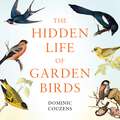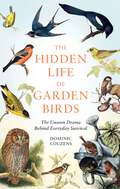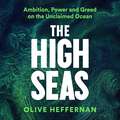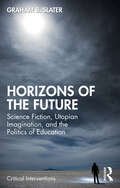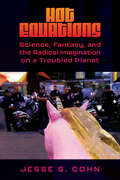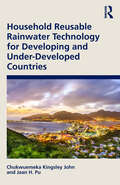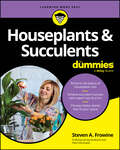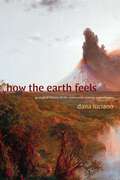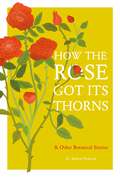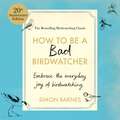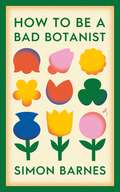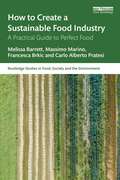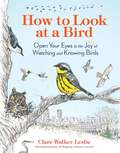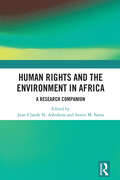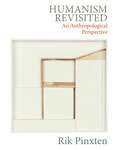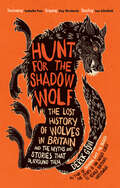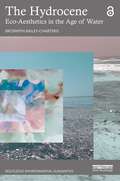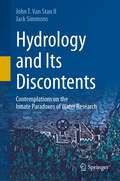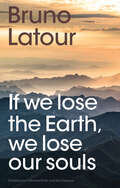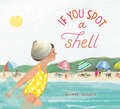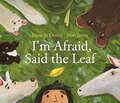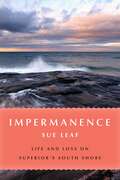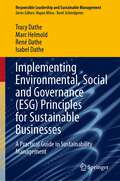- Table View
- List View
The Hidden Life of Garden Birds: The unseen drama behind everyday survival
by Dominic CouzensA glimpse into the secret lives of over 50 garden birds, with beautiful illustrations and intriguing facts.Did you know that woodpeckers are capable of learning simple codes? Hooded crows can form connections with humans? A jay's call affects the behaviour of surrounding squirrels?All these fascinating bird activities and more are revealed in The Hidden Life of Garden Birds. Unusual feeding behaviour is just the tip of the iceberg. From territorial conflict and strange relationships with man, to breeding and nesting oddities, this book exposes all the drama behind garden birds' everyday survival - making it the perfect gift for birdwatchers.The Hidden Life of Garden Birds will enlighten you to the secret going-ons of the common creatures you can spot from the comfort of your back doorstep.(p) 2024 Octopus Publishing Group
The Hidden Life of Garden Birds: The unseen drama behind everyday survival
by Dominic CouzensA glimpse into the secret lives of over 50 garden birds, with beautiful illustrations and intriguing factsDid you know that woodpeckers are capable of learning simple codes? Hooded crows can form connections with humans? A jay's call affects the behaviour of surrounding squirrels?All these fascinating bird activities and more are revealed in The Hidden Life of Garden Birds. Unusual feeding behaviour is just the tip of the iceberg. From territorial conflict and strange relationships with man, to breeding and nesting oddities, this book exposes all the drama behind garden birds' everyday survival - making it the perfect gift for birdwatchers.The Hidden Life of Garden Birds will enlighten you to the secret going-ons of the common creatures you can spot from the comfort of your back doorstep.
The Hidden Life of Garden Birds: The unseen drama behind everyday survival
by Dominic CouzensA glimpse into the secret lives of over 50 garden birds, with beautiful illustrations and intriguing factsDid you know that woodpeckers are capable of learning simple codes? Hooded crows can form connections with humans? A jay's call affects the behaviour of surrounding squirrels?All these fascinating bird activities and more are revealed in The Hidden Life of Garden Birds. Unusual feeding behaviour is just the tip of the iceberg. From territorial conflict and strange relationships with man, to breeding and nesting oddities, this book exposes all the drama behind garden birds' everyday survival - making it the perfect gift for birdwatchers.The Hidden Life of Garden Birds will enlighten you to the secret going-ons of the common creatures you can spot from the comfort of your back doorstep.
The High Seas: Ambition, Power and Greed on the Unclaimed Ocean
by Olive Heffernan'A vital, fascinating, deeply researched exploration of Earth's last wilderness...Shocking and starkly illuminating - a must-read.' Gaia VinceThe ocean covers seventy per cent of the surface of our planet, and two thirds of this lie beyond national borders. Owned by all nations and no nation simultaneously, these waters are home to some of the richest and most biodiverse environments on the planet. But they are also home to exploitation on a scale that few of us can imagine.Here, industry and economic progress rule and lax enforcement and apathy are the status quo. Out of sight and often out of mind, a battle rages to control, profit from, protect, or obliterate the world's largest, wildest commons. Heffernan sets sail on a journey to uncover the truth behind deeply exploitative fishing practices, investigate the potentially devastating impact of deep-sea mining, and hold to task the Silicon-valley interventionists whose solutions to climate change are often wildly optimistic, radically irresponsible or both.The result is a forceful and deeply researched manifesto calling for the protection and preservation of this final frontier - the last vestiges of wilderness on Earth.
Horizons of the Future: Science Fiction, Utopian Imagination, and the Politics of Education (Critical Interventions)
by Graham B. SlaterHorizons of the Future: Science Fiction, Utopian Imagination, and the Politics of Education examines the relationship between science fiction, education, and social change in the 21st century.Global capitalism is ecologically unsustainable and ethically indefensible; time is running out to alter the course of history if humanity is to have hope of a livable future beyond the next century. However, alternatives are possible, offering much more equality, care, justice, joy, and hope than the established order. Popular culture and schools are key sites of struggles to imagine such alternatives. Drawing on critical theory, cultural studies, and sociology, Slater articulates the promising connection between science fiction and the future of education. He offers cutting-edge engagement with themes, perspectives, and modes of imagination in science fiction that can be mobilized politically and pedagogically to envision and enact critical forms of education that cultivate new utopian ways of relating to self, society, and the future.This thought-provoking book will be of interest to scholars and students in the social sciences and education.
Hot Equations: Science, Fantasy, and the Radical Imagination on a Troubled Planet
by Jesse S. CohnInspired by the new diversity of science fiction, fantasy, and horror in the twenty-first century, Hot Equations: Science, Fantasy, and the Radical Imagination on a Troubled Planet confronts the kinds of literary and political “realism” that continue to suppress the radical imagination. Alluding both to the ongoing climate catastrophe and to Tom Godwin’s “The Cold Equations”—that famous touchstone of “hard science fiction”—Hot Equations reads the crises of our "post-normal" moment via works that increasingly subvert genre containment and spill out into the public sphere. Drawing on archives and contemporary theory, author Jesse S. Cohn argues that these imaginative works of science fiction, fantasy, and horror strike at the very foundations of modernity, calling its basic assumptions into question. They threaten the modern order with a simultaneously terrible and promising anarchy, pointing to ways beyond the present medical, ecological, and political crises of pandemic, climate change, and rising global fascism. Examining books ranging from well-known titles like The Hunger Games and The Caves of Steel to newer works such as Under the Pendulum Sun and The Stone Sky, Cohn investigates the ways in which science fiction, fantasy, and horror address contemporary politics, social issues, and more. The “cold equations” that established normal life in the modern world may be in shambles, Cohn suggests, but a New Black Fantastic makes it possible for the radical imagination to glimpse viable possibilities on the other side of crisis.
Household Reusable Rainwater Technology for Developing and Under-Developed Countries
by Chukwuemeka Kingsley John Jaan H. PuHousehold Reusable Rainwater Technology for Developing and Under-Developed Countries provides insight into household techniques for collecting and treating harvested rainwater safely for both potable and nonpotable uses, as well as practices to improve its quality, with numerous realworld case studies and data. It gives a comprehensive, holistic account on the household scale for both developing and under-developed countries. Improvement mechanisms such as the impacts of first flush, household water treatment techniques, and sedimentation in the harvested water are described in depth together with the advantages and disadvantages of their common practices in developing and under-developed societies. Also discussed is a comprehensive survey illustrating the impact of rainwater sources on the daily life of a carefully selected community from the perspective of its residents. The book is ideal for students, researchers, academics, water policy providers, and bodies worldwide such as WHO and DFID.
Houseplants & Succulents For Dummies
by Steven A. FrowineBecome the best plant parent you can be Houseplant hysteria is here to stay. For new and seasoned plant owners alike, Houseplants & Succulents For Dummies is the ideal resource on plant care, growing cycles, unique plant varieties, and all the essentials you need to know about your rooted friends. Ensure that your sprouts grow and thrive, with tons of tips and answers to all your questions. Are they getting enough light? Are you overwatering? Why are the leaves turning yellow? This fun Dummies guide teaches you to find the right plants for your personal plant care style, identify common varieties, choose the right potting soil, and pick the perfect little nook for your leaf baby. You’ll also learn how to rescue your plants when pests and diseases strike, and even how to use plants as part of a stylish home décor approach. Get growing! Learn about the different types of plants and choose the ones that will work for you Figure out how to keep your plants happy—and what to do about it if they’re not Determine how often to water plants, what type of soil they need, and how much light Improve your mental and respiratory health by filling your home with plantsGrab this handy book if you’re new to the houseplant craze and want a user-friendly, comprehensive guide on plant care. Intermediate and advanced plant parents will also love this handy reference with info on the latest plant trends and new varieties.
How the Earth Feels: Geological Fantasy in the Nineteenth-Century United States (ANIMA: Critical Race Studies Otherwise)
by Dana LucianoIn How the Earth Feels Dana Luciano examines the impacts of the new science of geology on nineteenth-century US culture. Drawing on early geological writings, Indigenous and settler accounts of earthquakes, African American antislavery literature, and other works, Luciano reveals how geology catalyzed transformative conversations regarding the intersections between humans and the nonhuman world. She shows that understanding the earth’s history geologically involved confronting the dynamic nature of inorganic matter over vast spans of time, challenging preconceived notions of human agency. Nineteenth-century Americans came to terms with these changes through a fusion of fact and imagination that Luciano calls geological fantasy. Geological fantasy transformed the science into a sensory experience, sponsoring affective and even erotic connections to the matter of the earth. At the same time, it was often used to justify accounts of evolution that posited a modern, civilized, and Anglo-American whiteness as the pinnacle of human development. By tracing geology’s relationship with biopower, Luciano illuminates how imagined connections with the earth shaped American dynamics of power, race, and colonization.
How the Rose Got Its Thorns: And Other Botanical Stories
by Dr Andrew OrmerodHave you ever wondered why the rose has thorns and other flowers don't; why the daffodil is the colour it is; or why some plants have shiny leaves and others matt?How The Rose Got its Thorns reveals the inner workings of our favourite flowers and trees. Designed to help gardeners, both novice and experienced, better understand how plants grow, the book is easy to navigate - it is divided into 50 chapters, each one a story.Accompanied by specially commissioned colour illustrations, each chapter explains the science behind how plants work and the extraordinary processes they have evolved: such as protecting themselves from predators using chemicals; attracting pollinators using scent, shape and colour; growing in low or high temperatures; their relationship with the wind; the size and pattern of their leaves; the distribution of their seeds and survival strategies; their relationship with insects; how they allocate their resources; and how they retain water efficiently.This delightful and intriguing book offers readers an accessible way to better understand how our plants evolved into the species of today.
How the Rose Got Its Thorns: And Other Botanical Stories
by Dr Andrew OrmerodHave you ever wondered why the rose has thorns and other flowers don't; why the daffodil is the colour it is; or why some plants have shiny leaves and others matt?How The Rose Got its Thorns reveals the inner workings of our favourite flowers and trees. Designed to help gardeners, both novice and experienced, better understand how plants grow, the book is easy to navigate - it is divided into 50 chapters, each one a story.Accompanied by specially commissioned colour illustrations, each chapter explains the science behind how plants work and the extraordinary processes they have evolved: such as protecting themselves from predators using chemicals; attracting pollinators using scent, shape and colour; growing in low or high temperatures; their relationship with the wind; the size and pattern of their leaves; the distribution of their seeds and survival strategies; their relationship with insects; how they allocate their resources; and how they retain water efficiently.This delightful and intriguing book offers readers an accessible way to better understand how our plants evolved into the species of today.
How to be a Bad Birdwatcher Anniversary Edition: Embrace the everyday joy of birdwatching – to the greater glory of life
by Simon BarnesTHE BESTSELLING BIRDWATCHING CLASSIC - 20TH ANNIVERSARY EDITION'A delightful ode to the wild world outside the kitchen window - leaves you with the warm feeling that a shared love conquers all.' The Daily Telegraph'A witty, perceptive book; thoughtful, instructive and full of simple wisdom.' The Daily MailLook out the window. See a bird. Enjoy it. CONGRATULATIONS! You are now a bad birdwatcher.Anyone who has ever gazed up at the sky or stared out of the window knows something about birds. In this fun, eye-opening and inspiring book, award-winning nature writer Simon Barnes paints a riveting picture of how birdwatching has framed his life and can help us all to a better understanding of our place on this planet.How to be a Bad Birdwatcher shows why birdwatching is not the preserve of twitchers, but one of the simplest, cheapest and most rewarding pastimes around.
How to be a Bad Botanist
by Simon BarnesCan you tell a tomato from a grape? Lawn from an oak tree? Then congratulations - you are a botanist. Self-confessed bad birdwatcher Simon Barnes thought he knew nothing about plants. He didn't object to them: trees are interesting, because birds perch in them; plants are useful as they create habitats and birds live in habitats. But while admiring the tenacity of some sea kale and yellow-horned poppy to thrive on an inhospitable shingle beach, he was struck by a truth - it all begins with plants. In this funny and inspiring book, Simon Barnes tells the story of a lifelong relationship with plants, and the realisation of the fact. Taking us from thinking ourselves ignorant about plants, to gently starting to observe seasons, patterns and places, Barnes guides us on a journey to better observing the beauty and diversity of the natural world. Both a primer on how to appreciate the plants around us and an exploration on how they make our external and interior worlds, How to be a Bad Botanist opens our eyes to the wonders around us. Plants are everywhere, in every part of your life, and you know more than you think.
How to Create a Sustainable Food Industry: A Practical Guide to Perfect Food (Routledge Studies in Food, Society and the Environment)
by Melissa Barrett Massimo Marino Francesca Brkic Carlo Alberto PratesiThis book presents a practical guide to help businesses navigate the complex topics of sustainability in the food industry. The book takes you on a journey along the food value chain, from farm to fork, exploring key opportunities to increase positive impacts and circularity at each step of the journey. Written by a team of authors with decades of experience in the food industry and academia, it provides guidance on how to analyse sustainability across the value chain and life cycle of a food product and how to design, implement and communicate strategies to customers. Furthermore, the book shows that there are not always straightforward solutions, but rather choices and trade-offs that require an understanding of what is best suited to the product, customers and business in question. It demystifies a variety of topics, such as local sourcing, regenerative agriculture, plant-based protein and the environmental impact of meat production, and draws on a wide range of case studies from across the globe, to provide concrete, real-world examples. While a perfect food system may not exist, informed decisions can go a long way to reshape and transform the food industry as we know it. This book will be of great interest to professionals working in the food and agriculture industries, as well as students and scholars of sustainable food systems and sustainable business.
How to Look at a Bird: Open Your Eyes to the Joy of Watching and Knowing Birds
by Clare Walker LeslieBestselling author and acclaimed nature illustrator Clare Walker Leslie invites beginning birdwatchers to hone their observational skills with this easy-to-use visual guide. Using her signature nature journal illustrations, Leslie shows readers the key clues to look for, from the shape of the beak or talons to distinctive feather colorings, flight patterns, and behavioral traits. She offers simple prompts that encourage readers to embrace curiosity and take a closer look: Where are you? What season is it? How is that bird moving or eating? With an emphasis on the birds that are most likely to be seen at a feeder, in a city park, or at a nature preserve, How to Look at a Bird makes bird watching, identification, and appreciation accessible to everyone, no matter where they live. This publication conforms to the EPUB Accessibility specification at WCAG 2.0 Level AA.
Human Rights and the Environment in Africa: A Research Companion
by Jean-Claude N. Ashukem Semie M. SamaThe relationship between human rights and the environment, as evidenced by the recent UN Resolution on the human right to a healthy environment, is a topical, fascinating, uneasy, and increasingly urgent one. This timely collection explores the inextricable relationship between human rights and the environment as a critical lens for understanding and addressing key human rights and environmental issues confronting Africa. The work explores theoretical, philosophical, doctrinal, and empirical research to interrogate and provide clarity on how and whether the human rights-based approach to environmental protection and policy implications has been effective in enhancing environmental protection and sustainability in Africa. It brings together an elite group of African and international experts to investigate the increasing connectivity and problems with African human rights, environmental governance, and the quest for sustainability. The book is divided into thematic clusters, including: the right of vulnerable communities to sustainability; climate change, the right to development and natural resource governance; corporate environmental responsibility and sustainability; the philosophy of environmental ethics and theories of human rights approaches to environmental governance; procedural environmental rights; the role of the judiciary in environmental protection; and desertification. These themes provide a structure to investigate and clarify specific fundamental questions on Africa’s environmental governance paradigm. This innovative contribution provides an interdisciplinary approach to the philosophical interrelationship and use of human rights approaches to ensure and enhance environmental protection and sustainability. As such, the book will be of interest to African scholars, researchers and students in Human Rights Law, Environmental Studies, Political Science, Ecology and Conservation and Development Studies. It will also be a valuable resource for policymakers, governments, NGOs, practitioners, and all those interested in African environmental governance.
Humanism Revisited: An Anthropological Perspective
by Rik PinxtenThe West emancipated itself from the old humanism long ago and in doing so distanced itself from ‘heteronomy’: it declared that man, and not a non-human power, should be the first reference to approach people and nature. Today, as heirs of this tradition, we are still stuck in Eurocentrism (and often racism), and now even threaten to ruin nature by destroying biodiversity and causing the climate to warm up dangerously. Applied through an anthropological perspective, this book calls for a NEED-humanism: Not-Eurocentric, Ecological and (economically) Durable approach that can help promote inclusion and pluralism.
Hunt for the Shadow Wolf [US Edition]: The lost history of wolves in Britain and the myths and stories that surround them
by Derek Gow"Terrific, life-lit moments come howling out of Hunt for the Shadow Wolf."—The Telegraph "[Derek Gow is] a wry, profane truth teller who is equal parts yeoman farmer, historical ecologist, and pirate."—Ben Goldfarb, author of Eager and Crossings "Beautifully crafted, fascinating and unbearably poignant, I totally loved this book."—Isabella Tree, author of Wilding Renowned rewilder Derek Gow has a dream: that one day we will see the return of the wolf to Britain as it has already returned elsewhere. As Derek worked to reintroduce the beaver, he began to hear stories of the wolf, both real and mythical, and his fascination with this creature grew. With increasing curiosity, Derek started to piece together fragments of information, stories and artefacts to reveal a shadowy creature that first walked proud through these lands and then was hunted to extinction as coexistence turned to fear, hatred – and domination. What Derek came to realize was that the underlying motives behind our hatred were actually far more prosaic and, like most persecutions, to do with power and profit. We turned the wolf into a savage beast and saw its extirpation as a civilizing mission. But the wolf survived far longer than many thought and Derek tells of his sightings of the wolf through folklore and mythology, the records of grand estates and parish churches as well as wolf heads, both real and recreated. With bitingly funny but also tender stories, Hunt for the Shadow Wolf is Derek’s quest to uncover the true nature of this creature because, as we seek to heal our landscape, we must reconcile our relationship with it. Before we can even begin to bring the wolf back, we need to understand it. "I have loved this chase dearly and though what unfolds might be an ending of sorts, I have no intention to let this hunt cease."―Derek Gow, from Hunt for the Shadow Wolf "Gow reinvents what it means to be a guardian of the countryside."—The Guardian
The Hydrocene: Eco-Aesthetics in the Age of Water (ISSN)
by Bronwyn Bailey-CharterisThis book challenges conventional notions of the Anthropocene and champions the Hydrocene: the Age of Water. It presents the Hydrocene as a disruptive, conceptual epoch and curatorial theory, emphasising water's pivotal role in the climate crisis and contemporary art.The Hydrocene is a wet ontological shift in eco-aesthetics which redefines our approach to water, transcending anthropocentric, neo-colonial and environmentally destructive ways of relating to water. As the most fundamental of elements, water has become increasingly politicised, threatened and challenged by the climate crisis. In response, The Hydrocene articulates and embodies the distinctive ways contemporary artists relate and engage with water, offering valuable lessons towards climate action. Through five compelling case studies across swamp, river, ocean, fog and ice, this book binds feminist environmental humanities theories with the practices of eco-visionary artists. Focusing on Nordic and Oceanic water-based artworks, it demonstrates how art can disrupt established human–water dynamics. By engaging hydrofeminist, care-based and planetary thinking, The Hydrocene learns from the knowledge and agency of water itself within the tide of art going into the blue.The Hydrocene urgently highlights the transformative power of eco-visionary artists in reshaping human–water relations. At the confluence of contemporary art, curatorial theory, climate concerns and environmental humanities, this book is essential reading for researchers, curators, artists, students and those seeking to reconsider their connection with water and advocate for climate justice amid the ongoing natural-cultural water crisis.The Open Access version of this book, available at http://www.taylorfrancis.com, has been made available under a Creative Commons Attribution-Non Commercial-No Derivatives (CC-BY-NC-ND) 4.0 license.
Hydrology and Its Discontents: Contemplations on the Innate Paradoxes of Water Research
by John T. Van Stan II Jack SimmonsThis book examines the intricate web linking water science and society using diverse philosophical lenses. Highlighting the tensions within the threads of this web, we spotlight major conceptual tightropes that water researchers tread daily. To effectively navigate these delicate threads, a 'healthy' tension in the encompassing web is necessary. Drawing inspiration from Freud's examination of tensions in "Society and Its Discontents," we illuminate the tension-filled paradoxes inherent to water science, emphasizing the challenges in keeping these paradoxical threads taut enough to ensure a navigable and sustainable bond with society. Central to our narrative is the escalating societal urge to quantify and 'manage' water—something interwoven throughout every environmental layer, including the fabric of our being. An excessive focus on management may alienate users from their water realities, jeopardizing the vital threads that sustainability tether water science and society. Consequently, this book explores compelling and inescapable tensions that resist tidy universal resolution, such as: the language of water science, including its mathematical reductions (i.e., models); the effect of water's commodification on its science; hydrology’s intersection with colonialism; and other concerns that reveal distortions in our hydrology. We aim to aid water professionals in recognizing and fine-tuning the paradoxes intrinsic to their work. To underscore the interwoven complexity of contemporary hydrology, "Hydrology and Its Discontents" guides readers into the tempestuous depths of water research, all the while urging a recalibration of perspectives and motivations.
If we lose the Earth, we lose our souls
by Bruno LatourIn this book Bruno Latour calls upon Christians to join the struggle to avert a climate catastrophe. First and foremost, Christians need to overcome their lack of interest in “earthly things” and pay attention to the Earth at a time when it is being neglected. He also urges Christians to renew their understanding of their faith in the context of the new image of the world that has emerged from earth system science – that of a world in which the myriad of beings that inhabit the world are interdependent and living in close proximity on a slender, fragile membrane on the surface of the planet. This new image of the world cannot fail to have an impact on the sciences, on politics, and on religion, just as, in earlier centuries, the cosmology of Copernicus and Galileo upset the old order. Latour sees the ecological crisis, and the cosmological mutation that it entails, as an opportunity to convey anew, to the largest possible audience, the tradition of Christianity as it has never been appreciated before, by bringing to bear the lessons of eschatology on the great crisis that looms before us all.
If You Spot a Shell (If You Find a Treasure Series)
by Aimée SicuroA stunning companion to If You Find a Leaf, this cheery picture book captures the excitement of summer and encourages children to see their collected seashells in an entirely new way. The artist incorporates real shells into her exquisite illustrations.A warm summer breeze and the gentle waves of the ocean wash ashore many different types of shells. In this story a girl collects shells and thinks of all the magnificent things they can be turned into with a little creativity. She imagines one shell as a swimming cap for diving into the crashing waves, another as a magical kaleidoscope, one as a rocket ship to take her way up high and another as a submarine for exploring the wonders of the world below. The girl draws inspiration from the unique beauty of each and every shell.In this joyous celebration of a day at the beach, artist Aimee Sicuro uses real shells she&’s hand selected to make her oh-so-charming illustrations. Any young reader who turns the pages of this beautiful book will be inspired to use their own imagination as they comb the beach for shells this summer.
I'm Afraid, Said the Leaf
by Danielle DanielA touching, playful exploration of empathy and interdependency from an acclaimed author and illustrator.I&’m afraid, Said the leaf. / You&’re not alone, Said the tree. But who will comfort a nervous bird, a lonely crab, a lost wolf? How can a horse find warmth, a snail some cheer, a child some rest? Through a series of amusing and soothing exchanges, this deceptively simple and profound picture book depicts different pairings to celebrate interconnectedness and underlines the importance of caring for every living organism to ensure a strong and healthy natural world. I&’m Afraid, Said the Leaf invites young readers to understand that we all need each other for support and survival — and that we're all stronger together.
Impermanence: Life and Loss on Superior's South Shore
by Sue LeafA personal journey through the ever-changing natural and cultural history of Lake Superior&’s South Shore Lake Superior&’s South Shore is as malleable as it is enduring, its red sandstone cliffs, clay bluffs, and golden sand beaches reshaped by winds and water from season to season—and sometimes from one hour to the next. Generations of people have inhabited the South Shore, harvesting the forests and fish, mining copper, altering the land for pleasure and profit, for better or worse. In Impermanence, author Sue Leaf explores the natural and human histories that make the South Shore what it is, from the gritty port city of Superior, Wisconsin, to the shipping locks at Sault Ste. Marie, Michigan. For Leaf, what began as a bicycling adventure on the coast of Lake Superior in 1977 turned into a lifelong connection with the area, and her experience, not least as owner of a rustic cabin on a rapidly eroding lakeside cliff, imbues these essays with a passionate sense of place and an abiding curiosity about its past and precarious future. As waves slowly consume the shoreline where her family has spent countless summers, Leaf is forced to confront the complexity of loving a place that all too quickly is being reclaimed by the great lake. Impermanence is a journey through the South Shore&’s story, from the early days of the Anishinaabe and fur traders through the heyday of commercial fishing, lumber camps, and copper mining on the Keweenaw Peninsula to the awakening of the Northland to the perils and consequences of plundering its natural splendor. Noting the geological, ecological, and cultural features of each stop on her tour along the South Shore, Leaf writes about the restoration of the heavily touristed Apostle Islands National Lakeshore to its pristine conditions, even as Lake Superior maintains its allure for ice fishers, kayakers, and long-distance swimmers. She describes efforts to protect the endangered piping plover and to preserve the diverse sand dunes on the Michigan coast, and she observes the slough that supports rare intact wild rice beds central to Anishinaabe culture. Part memoir, part travelogue, part natural and cultural history, Leaf&’s love letter to Lake Superior&’s South Shore is an invitation to see this liminal world in all its seasons and guises, to appreciate its ageless, ever-changing wonders and intimate charms.
Implementing Environmental, Social and Governance: A Practical Guide in Sustainability Management (Responsible Leadership and Sustainable Management)
by Tracy Dathe Marc Helmold René Dathe Isabel DatheThe concept of environmental, social and governance (ESG) is rapidly emerging as the new global industry standard and an important benchmarking tool for socially responsible investments. Major corporations seek the expertise of specialized consultants to develop and implement tailored ESG framework for their businesses. This book offers a guide to ESG and its practical applications. Beyond introducing the structured procedures of the most common ESG approaches, it delves into the comprehensive impact on the value chain, providing practical insights. The text explores the latest trends in various business sectors, offering insights into their ESG practices. Closing with a forward-looking perspective, the book anticipates future developments such as climate change management and ESG certifications, while also addressing potential pitfalls encapsulated by the term “greenwashing”.Written by authors with a solid background in teaching and research, the book establishes a robust theoretical foundation. The inclusion of numerous practical examples and country-specific recommendations enhances this book’s applicability and makes it an invaluable resource to those navigating the complexities of ESG.
